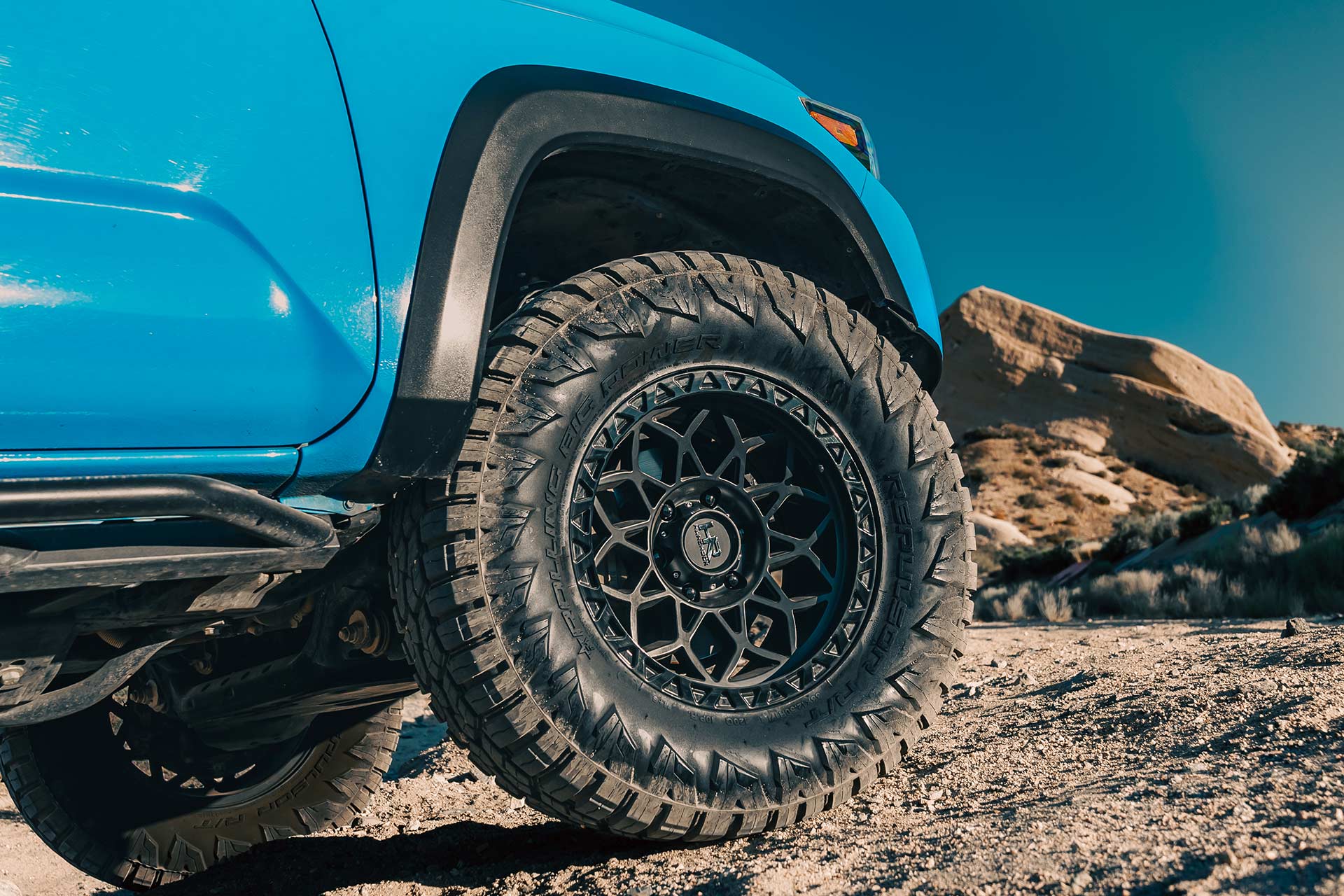The Truth About Beadlock Wheels
If you go off-roading or overlanding, you’ve probably heard of or seen beadlock off-road wheels. Sure, beadlock wheels look cool, and all the hardcore trail rigs are running them, but why? There are some questions that need to be answered before committing to a set of beadlocks. Do you need beadlock off-road wheels? Are they safe? What are the benefits of a beadlock versus a non-beadlock? As off-road enthusiasts ourselves, we get these questions often. At Hardrock Offroad, we’ve done rigorous testing, not only from a manufacturing standpoint but also from individual experiences on and off the trails. Let’s take a deeper look into beadlock wheels and some common misconceptions.
WHAT ARE BEADLOCK WHEELS?
Beadlock wheels do exactly what the name suggests: they lock the tire’s bead to the rim of the wheel. Historically, this type of wheel was initially developed for military use and was known as “combat wheels.” These wheels were later adopted and popularized by the off-roading community. The original purpose of beadlock wheels was to prevent tires from dismounting under load, maintain tire integrity in combat situations, and facilitate quick tire replacements.
Today, beadlock wheels are often used in extreme off-road conditions such as rock crawling and expert-level trails. It’s important to understand when and why to use beadlocks before installing them on your vehicle. The truth is, you may not need beadlocks at all.
WHY DO OFF-ROAD ENTHUSIASTS USE BEADLOCKS?
The answer is quite simple. Off-roaders often air down their tires to improve ride quality and performance on the trail. This adjustment makes navigating through sand, mud, dirt, and rocks much easier compared to using fully pressurized tires. However, there are risks associated with reducing tire pressure.
With factory wheels and non-beadlock off-road wheels, you can safely lower tire pressure to roughly 12-20 psi without worrying about the tire bead dislodging from the wheel. In contrast, true beadlock wheels allow you to reduce tire pressure to as low as 5-7 psi without experiencing de-beading issues.

BEADLOCK VS NON-BEADLOCK WHEELS
You’re probably wondering how beadlock and non-beadlock wheels stack up against each other. The truth is, both have their benefits and it completely depends on your specific use-case. However, there are a few important things to consider before committing to a particular set of wheels.
Unless you plan to take on the most difficult trails, beadlock wheels are not a must-have item for your off-road rig. It’s important to note that these types of wheels are not only relatively expensive, but most, if not all are not DOT (Department of Transportation) legal and approved. That means you cannot legally drive your rig on the street or highway with them installed.
In addition, beadlock wheels are heavier, harder to balance, and have an increased chance of beadlock bolts breaking, which can cause major issues in on-road use if not installed and torqued down correctly. On the flip side, many manufacturers, including Hardrock Offroad, offer off-road wheels with beadlock styling that are totally safe for on-road and off-road use.
| Feature | Beadlock Wheels | Cast Wheels |
|---|---|---|
| Traction | Superior in Extreme Conditions | Adequate for Most Scenarios |
| Tire Pressure | Can Run Very Low Pressures | Standard Pressure |
| Durability | High in Extreme Terrains | Good for General Use |
| Installation | Complex and Time-Consuming | Simple and Quick |
| Maintenance | High | Low |
| Legal Use | Often Restricted | Generally Unrestricted |
| Cost | High | Low |
PROS & CONS OF BEADLOCK WHEELS
PROS
- The ability to air-down tire pressure to lower levels (5-7 psi) and improve traction in sand, snow, mud and more.
- Beadlock wheels are relatively stronger and more durable in extreme off-road situations.
- They look great aesthetically.
CONS
- Beadlock wheels are heavier due to more material and equipment used to manufacture them.
- In most cases, beadlocks are not legal for on-road use due to DOT regulations. Because of this, there’s a possibility of damage and tire blowout which can lead to serious safety concerns.
- The cost of such wheels are higher because of manufacturing and engineering costs.
- Most tire shops won’t offer mounting and balancing of beadlocks for legal reasons.
TO BEAD OR NOT TO BEAD?
At the end of the day, it comes down to what your intentions are with your vehicle and what you feel is right for you. Always remember to consider the risks and liability that comes from improper use and incorrect installation of wheels and bolts. If you love the style of beadlock wheels but don’t want to run the risks associated with them, then Hardrock Offroad offers styles with simulated beadlocks that look just as good without the drawbacks in our 100 Series collection of off-road wheels.
Frequently asked questions
What are beadlock wheels and how do they work?
Beadlock wheels do exactly what the name suggests: they mechanically lock your tire's bead to the wheel rim using a bolted ring. Unlike standard wheels that rely on air pressure to keep the tire seated, beadlocks physically clamp the tire in place. This prevents the tire from slipping off when aired down to extremely low pressures. They've become popular in extreme off-road applications where maintaining tire position is critical despite minimal air pressure.
Do I really need beadlock wheels for my off-road vehicle?
No, most off-road enthusiasts don't need beadlock wheels. Unless you're tackling expert-level trails or serious rock crawling, standard wheels are sufficient. With regular wheels, you can safely air down to 12-20 psi without experiencing issues. Beadlocks only become necessary when you need to run pressures as low as 5-7 psi for maximum traction in extreme conditions. For casual off-roading or overlanding, our standard off-road wheels provide all the performance you need without the additional complications.
Are beadlock wheels street legal?
No, most beadlock wheels are not DOT-approved for highway use. This is one of their biggest drawbacks - you can't legally drive on public roads with true beadlocks installed. This makes them impractical for daily drivers or vehicles that need to travel on highways to reach trail heads. If you want the beadlock look without the legal issues, our simulated beadlock wheels in the H100 Series collection offer the aesthetic appeal while remaining fully street legal.
What maintenance do beadlock wheels require?
Beadlock wheels demand significant ongoing maintenance. You need to check and retorque the beadlock bolts before every off-road trip as they can loosen during use. The bolts need periodic replacement due to wear and fatigue. Mounting and dismounting tires is also more complex and often can't be done at regular tire shops. This maintenance commitment is another reason why beadlocks only make sense for dedicated off-road rigs rather than vehicles that see regular street use.
How much more do beadlock wheels cost compared to regular wheels?
Beadlock wheels are considerably more expensive than standard off-road wheels due to their specialized construction and complex engineering. Beyond the higher initial purchase price, you'll face additional costs for proper installation, as many tire shops won't work on beadlocks. There are also ongoing expenses for replacement hardware and specialized mounting. For most off-roaders, this extra cost isn't justified by the limited benefits in typical trail conditions.
What are the safety concerns with beadlock wheels?
Safety is a major consideration with beadlocks. They require meticulous installation with proper torque specifications on all mounting bolts. Improperly installed beadlocks can lead to catastrophic failure. They're also heavier and harder to balance than standard wheels, which affects handling. The risk of beadlock bolts breaking during on-road use presents serious safety hazards if not properly maintained. These factors make them problematic for vehicles that aren't dedicated to extreme off-roading.
What alternatives exist to true beadlock wheels?
If you love the beadlock look but don't need their extreme capability, our H100 Series collection offers simulated beadlock styling without the drawbacks. These wheels provide the aggressive appearance while remaining DOT-compliant for street use. They're easier to maintain, less expensive, and don't require specialized installation. For most enthusiasts, these wheels deliver the perfect balance of style, performance, and practicality without compromising safety or legality.
When should I consider getting actual beadlock wheels?
You should only consider true beadlocks if you regularly participate in extreme off-road activities like rock crawling, competition events, or technical trails where ultra-low tire pressures are necessary. If you frequently find yourself in situations where standard wheels would experience bead separation at 12-15 psi, beadlocks might be justified. Otherwise, our simulated beadlock wheels offer the aesthetic appeal with none of the drawbacks for the vast majority of off-road applications.

